Tort Law Assignment: Case Analysis of Civil Liability Act 2002 NSW
VerifiedAdded on 2023/06/10
|11
|3430
|265
Report
AI Summary
This report presents a comprehensive analysis of a tort law assignment, focusing on key areas such as nuisance, false imprisonment, assault, and battery, under the Civil Liability Act 2002 NSW. The report begins with an introduction to tort law, specifically in the context of Australia, and outlines the relevant legislation, including the Civil Liability Act 2002 and the Civil Liability Amendment (Personal Responsibility) Act 2003. The main body of the report examines a case scenario involving Joanne and Samantha, analyzing the elements of private nuisance, false imprisonment, assault, and battery. It applies legal principles and case law to the facts, considering issues such as noise disturbance, trespass, and the actions taken by each party. The analysis includes discussions on the rules, applications of the rules, and potential defenses for each tort, culminating in a conclusion that summarizes the findings and provides a legal perspective on the case. The report is well-structured, referencing relevant legal concepts and case laws and concludes with a list of references including books and journals.
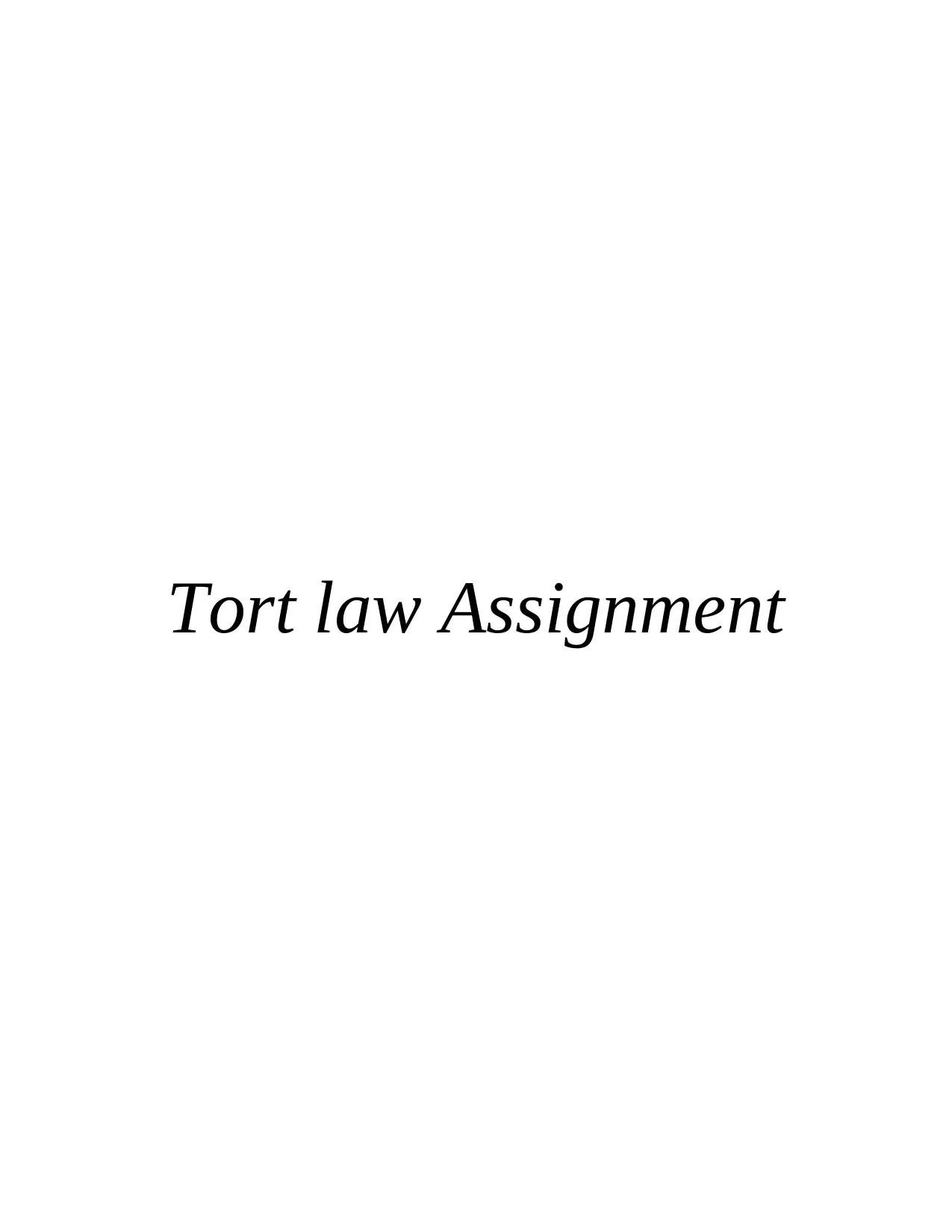
Tort law Assignment
Paraphrase This Document
Need a fresh take? Get an instant paraphrase of this document with our AI Paraphraser
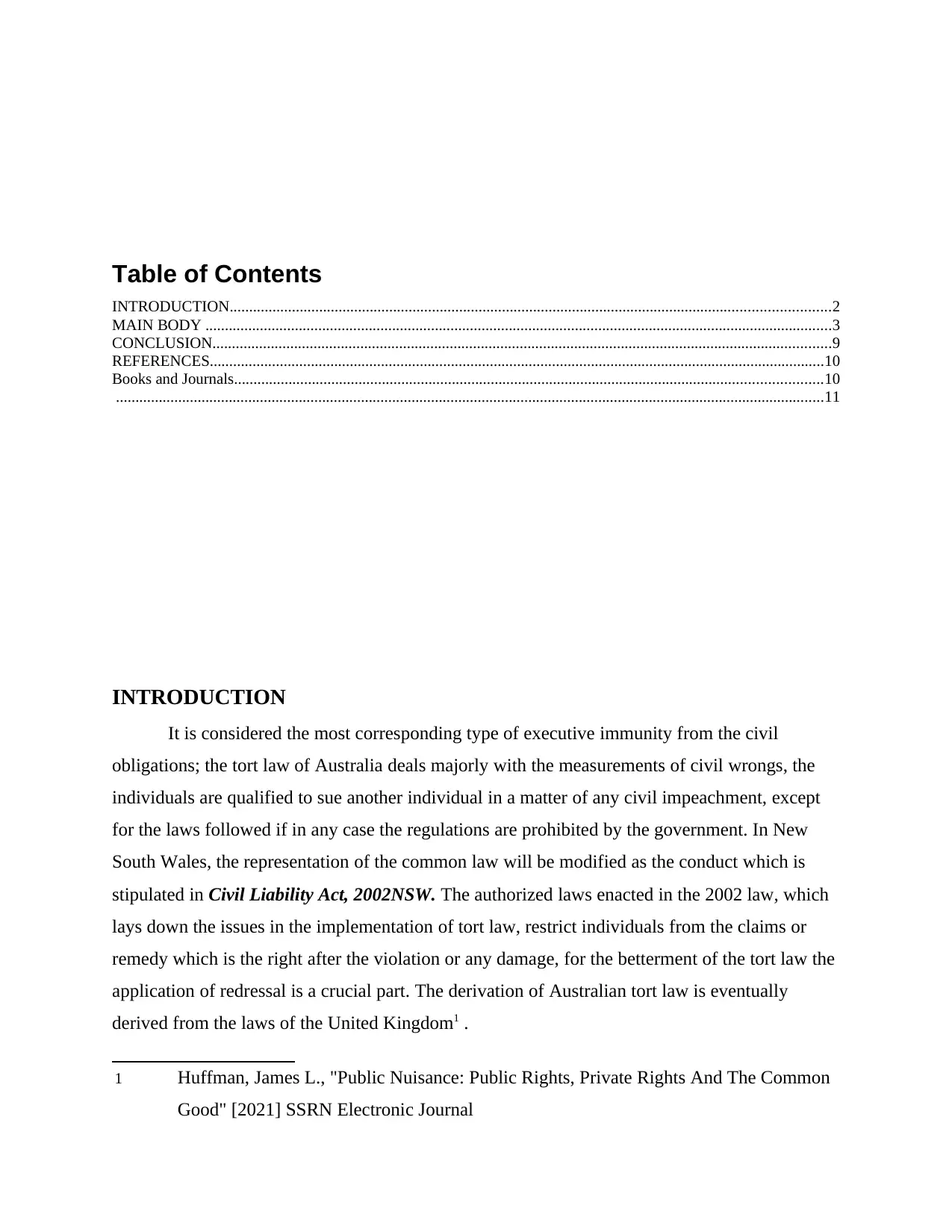
Table of Contents
INTRODUCTION..........................................................................................................................................................2
MAIN BODY .................................................................................................................................................................3
CONCLUSION...............................................................................................................................................................9
REFERENCES..............................................................................................................................................................10
Books and Journals.......................................................................................................................................................10
......................................................................................................................................................................................11
INTRODUCTION
It is considered the most corresponding type of executive immunity from the civil
obligations; the tort law of Australia deals majorly with the measurements of civil wrongs, the
individuals are qualified to sue another individual in a matter of any civil impeachment, except
for the laws followed if in any case the regulations are prohibited by the government. In New
South Wales, the representation of the common law will be modified as the conduct which is
stipulated in Civil Liability Act, 2002NSW. The authorized laws enacted in the 2002 law, which
lays down the issues in the implementation of tort law, restrict individuals from the claims or
remedy which is the right after the violation or any damage, for the betterment of the tort law the
application of redressal is a crucial part. The derivation of Australian tort law is eventually
derived from the laws of the United Kingdom1 .
1 Huffman, James L., "Public Nuisance: Public Rights, Private Rights And The Common
Good" [2021] SSRN Electronic Journal
INTRODUCTION..........................................................................................................................................................2
MAIN BODY .................................................................................................................................................................3
CONCLUSION...............................................................................................................................................................9
REFERENCES..............................................................................................................................................................10
Books and Journals.......................................................................................................................................................10
......................................................................................................................................................................................11
INTRODUCTION
It is considered the most corresponding type of executive immunity from the civil
obligations; the tort law of Australia deals majorly with the measurements of civil wrongs, the
individuals are qualified to sue another individual in a matter of any civil impeachment, except
for the laws followed if in any case the regulations are prohibited by the government. In New
South Wales, the representation of the common law will be modified as the conduct which is
stipulated in Civil Liability Act, 2002NSW. The authorized laws enacted in the 2002 law, which
lays down the issues in the implementation of tort law, restrict individuals from the claims or
remedy which is the right after the violation or any damage, for the betterment of the tort law the
application of redressal is a crucial part. The derivation of Australian tort law is eventually
derived from the laws of the United Kingdom1 .
1 Huffman, James L., "Public Nuisance: Public Rights, Private Rights And The Common
Good" [2021] SSRN Electronic Journal
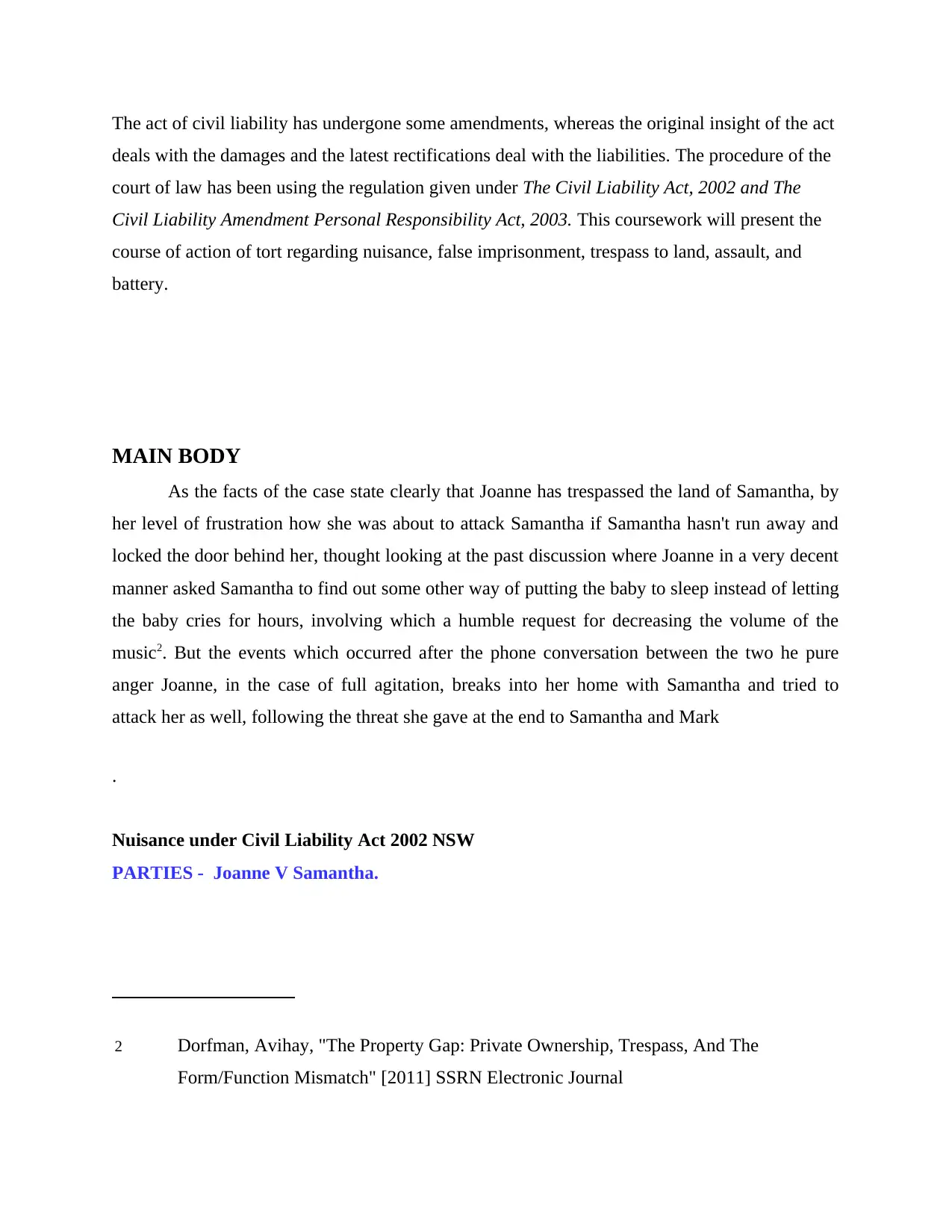
The act of civil liability has undergone some amendments, whereas the original insight of the act
deals with the damages and the latest rectifications deal with the liabilities. The procedure of the
court of law has been using the regulation given under The Civil Liability Act, 2002 and The
Civil Liability Amendment Personal Responsibility Act, 2003. This coursework will present the
course of action of tort regarding nuisance, false imprisonment, trespass to land, assault, and
battery.
MAIN BODY
As the facts of the case state clearly that Joanne has trespassed the land of Samantha, by
her level of frustration how she was about to attack Samantha if Samantha hasn't run away and
locked the door behind her, thought looking at the past discussion where Joanne in a very decent
manner asked Samantha to find out some other way of putting the baby to sleep instead of letting
the baby cries for hours, involving which a humble request for decreasing the volume of the
music2. But the events which occurred after the phone conversation between the two he pure
anger Joanne, in the case of full agitation, breaks into her home with Samantha and tried to
attack her as well, following the threat she gave at the end to Samantha and Mark
.
Nuisance under Civil Liability Act 2002 NSW
PARTIES - Joanne V Samantha.
2 Dorfman, Avihay, "The Property Gap: Private Ownership, Trespass, And The
Form/Function Mismatch" [2011] SSRN Electronic Journal
deals with the damages and the latest rectifications deal with the liabilities. The procedure of the
court of law has been using the regulation given under The Civil Liability Act, 2002 and The
Civil Liability Amendment Personal Responsibility Act, 2003. This coursework will present the
course of action of tort regarding nuisance, false imprisonment, trespass to land, assault, and
battery.
MAIN BODY
As the facts of the case state clearly that Joanne has trespassed the land of Samantha, by
her level of frustration how she was about to attack Samantha if Samantha hasn't run away and
locked the door behind her, thought looking at the past discussion where Joanne in a very decent
manner asked Samantha to find out some other way of putting the baby to sleep instead of letting
the baby cries for hours, involving which a humble request for decreasing the volume of the
music2. But the events which occurred after the phone conversation between the two he pure
anger Joanne, in the case of full agitation, breaks into her home with Samantha and tried to
attack her as well, following the threat she gave at the end to Samantha and Mark
.
Nuisance under Civil Liability Act 2002 NSW
PARTIES - Joanne V Samantha.
2 Dorfman, Avihay, "The Property Gap: Private Ownership, Trespass, And The
Form/Function Mismatch" [2011] SSRN Electronic Journal
⊘ This is a preview!⊘
Do you want full access?
Subscribe today to unlock all pages.

Trusted by 1+ million students worldwide
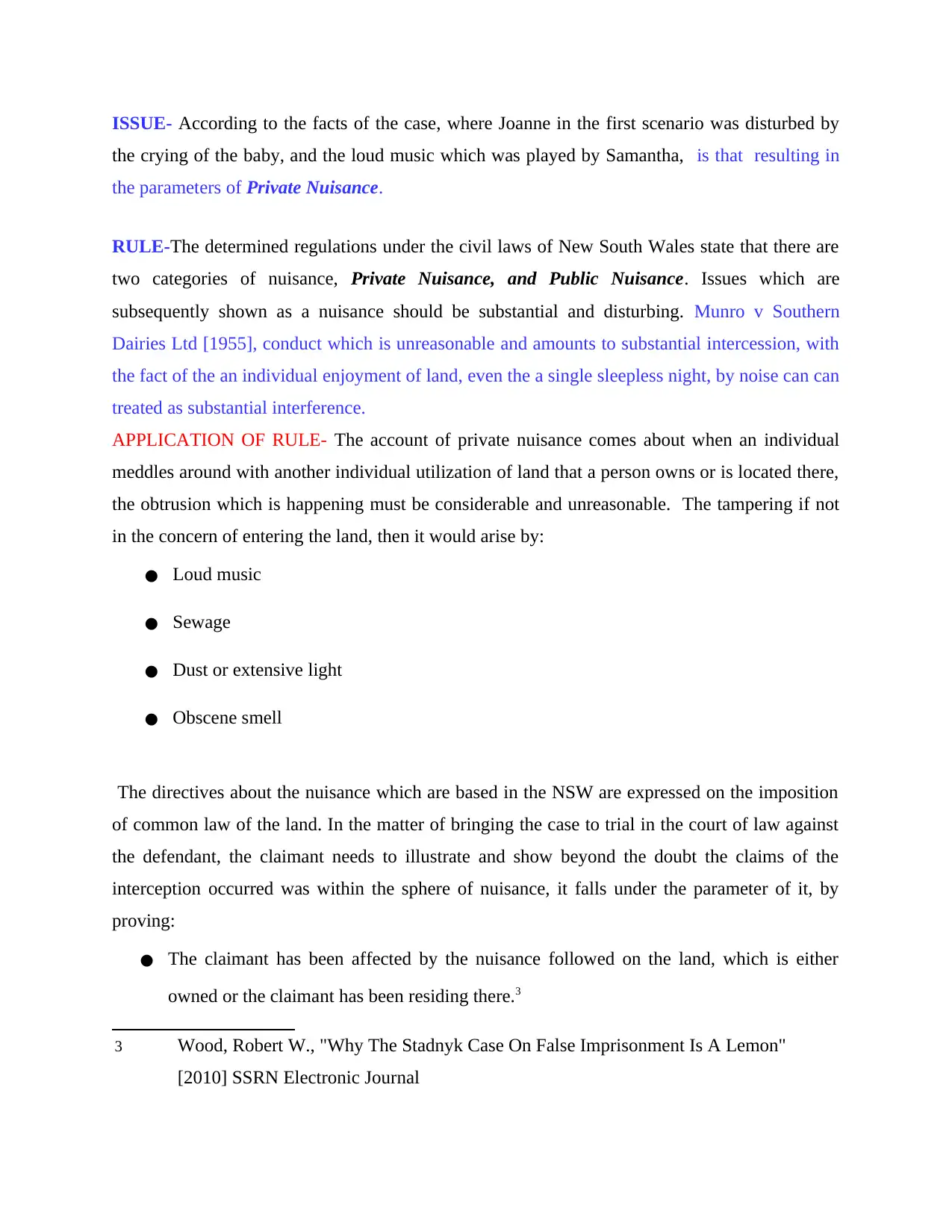
ISSUE- According to the facts of the case, where Joanne in the first scenario was disturbed by
the crying of the baby, and the loud music which was played by Samantha, is that resulting in
the parameters of Private Nuisance.
RULE-The determined regulations under the civil laws of New South Wales state that there are
two categories of nuisance, Private Nuisance, and Public Nuisance. Issues which are
subsequently shown as a nuisance should be substantial and disturbing. Munro v Southern
Dairies Ltd [1955], conduct which is unreasonable and amounts to substantial intercession, with
the fact of the an individual enjoyment of land, even the a single sleepless night, by noise can can
treated as substantial interference.
APPLICATION OF RULE- The account of private nuisance comes about when an individual
meddles around with another individual utilization of land that a person owns or is located there,
the obtrusion which is happening must be considerable and unreasonable. The tampering if not
in the concern of entering the land, then it would arise by:
● Loud music
● Sewage
● Dust or extensive light
● Obscene smell
The directives about the nuisance which are based in the NSW are expressed on the imposition
of common law of the land. In the matter of bringing the case to trial in the court of law against
the defendant, the claimant needs to illustrate and show beyond the doubt the claims of the
interception occurred was within the sphere of nuisance, it falls under the parameter of it, by
proving:
● The claimant has been affected by the nuisance followed on the land, which is either
owned or the claimant has been residing there.3
3 Wood, Robert W., "Why The Stadnyk Case On False Imprisonment Is A Lemon"
[2010] SSRN Electronic Journal
the crying of the baby, and the loud music which was played by Samantha, is that resulting in
the parameters of Private Nuisance.
RULE-The determined regulations under the civil laws of New South Wales state that there are
two categories of nuisance, Private Nuisance, and Public Nuisance. Issues which are
subsequently shown as a nuisance should be substantial and disturbing. Munro v Southern
Dairies Ltd [1955], conduct which is unreasonable and amounts to substantial intercession, with
the fact of the an individual enjoyment of land, even the a single sleepless night, by noise can can
treated as substantial interference.
APPLICATION OF RULE- The account of private nuisance comes about when an individual
meddles around with another individual utilization of land that a person owns or is located there,
the obtrusion which is happening must be considerable and unreasonable. The tampering if not
in the concern of entering the land, then it would arise by:
● Loud music
● Sewage
● Dust or extensive light
● Obscene smell
The directives about the nuisance which are based in the NSW are expressed on the imposition
of common law of the land. In the matter of bringing the case to trial in the court of law against
the defendant, the claimant needs to illustrate and show beyond the doubt the claims of the
interception occurred was within the sphere of nuisance, it falls under the parameter of it, by
proving:
● The claimant has been affected by the nuisance followed on the land, which is either
owned or the claimant has been residing there.3
3 Wood, Robert W., "Why The Stadnyk Case On False Imprisonment Is A Lemon"
[2010] SSRN Electronic Journal
Paraphrase This Document
Need a fresh take? Get an instant paraphrase of this document with our AI Paraphraser
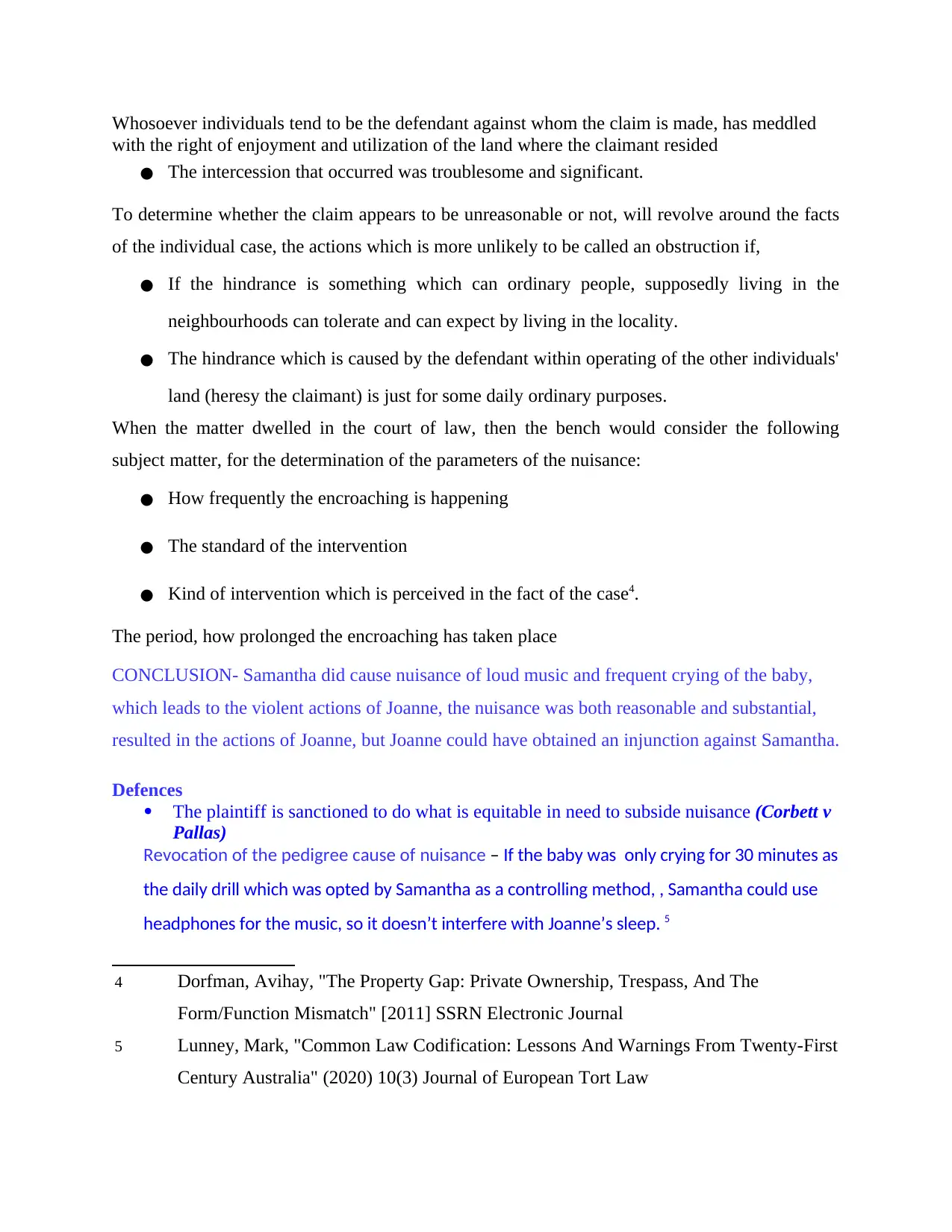
Whosoever individuals tend to be the defendant against whom the claim is made, has meddled
with the right of enjoyment and utilization of the land where the claimant resided
● The intercession that occurred was troublesome and significant.
To determine whether the claim appears to be unreasonable or not, will revolve around the facts
of the individual case, the actions which is more unlikely to be called an obstruction if,
● If the hindrance is something which can ordinary people, supposedly living in the
neighbourhoods can tolerate and can expect by living in the locality.
● The hindrance which is caused by the defendant within operating of the other individuals'
land (heresy the claimant) is just for some daily ordinary purposes.
When the matter dwelled in the court of law, then the bench would consider the following
subject matter, for the determination of the parameters of the nuisance:
● How frequently the encroaching is happening
● The standard of the intervention
● Kind of intervention which is perceived in the fact of the case4.
The period, how prolonged the encroaching has taken place
CONCLUSION- Samantha did cause nuisance of loud music and frequent crying of the baby,
which leads to the violent actions of Joanne, the nuisance was both reasonable and substantial,
resulted in the actions of Joanne, but Joanne could have obtained an injunction against Samantha.
Defences
The plaintiff is sanctioned to do what is equitable in need to subside nuisance (Corbett v
Pallas)
Revocation of the pedigree cause of nuisance – If the baby was only crying for 30 minutes as
the daily drill which was opted by Samantha as a controlling method, , Samantha could use
headphones for the music, so it doesn’t interfere with Joanne’s sleep. 5
4 Dorfman, Avihay, "The Property Gap: Private Ownership, Trespass, And The
Form/Function Mismatch" [2011] SSRN Electronic Journal
5 Lunney, Mark, "Common Law Codification: Lessons And Warnings From Twenty-First
Century Australia" (2020) 10(3) Journal of European Tort Law
with the right of enjoyment and utilization of the land where the claimant resided
● The intercession that occurred was troublesome and significant.
To determine whether the claim appears to be unreasonable or not, will revolve around the facts
of the individual case, the actions which is more unlikely to be called an obstruction if,
● If the hindrance is something which can ordinary people, supposedly living in the
neighbourhoods can tolerate and can expect by living in the locality.
● The hindrance which is caused by the defendant within operating of the other individuals'
land (heresy the claimant) is just for some daily ordinary purposes.
When the matter dwelled in the court of law, then the bench would consider the following
subject matter, for the determination of the parameters of the nuisance:
● How frequently the encroaching is happening
● The standard of the intervention
● Kind of intervention which is perceived in the fact of the case4.
The period, how prolonged the encroaching has taken place
CONCLUSION- Samantha did cause nuisance of loud music and frequent crying of the baby,
which leads to the violent actions of Joanne, the nuisance was both reasonable and substantial,
resulted in the actions of Joanne, but Joanne could have obtained an injunction against Samantha.
Defences
The plaintiff is sanctioned to do what is equitable in need to subside nuisance (Corbett v
Pallas)
Revocation of the pedigree cause of nuisance – If the baby was only crying for 30 minutes as
the daily drill which was opted by Samantha as a controlling method, , Samantha could use
headphones for the music, so it doesn’t interfere with Joanne’s sleep. 5
4 Dorfman, Avihay, "The Property Gap: Private Ownership, Trespass, And The
Form/Function Mismatch" [2011] SSRN Electronic Journal
5 Lunney, Mark, "Common Law Codification: Lessons And Warnings From Twenty-First
Century Australia" (2020) 10(3) Journal of European Tort Law
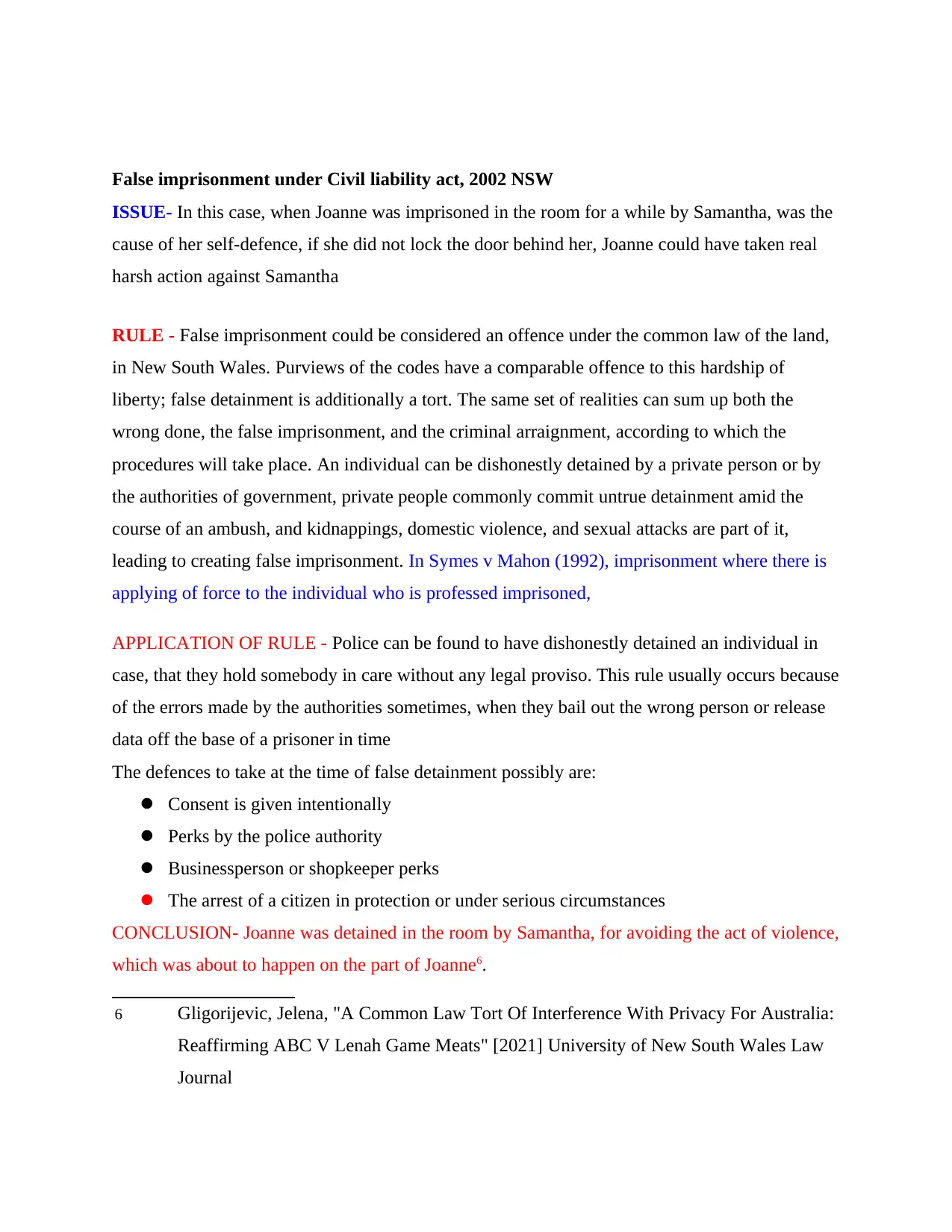
False imprisonment under Civil liability act, 2002 NSW
ISSUE- In this case, when Joanne was imprisoned in the room for a while by Samantha, was the
cause of her self-defence, if she did not lock the door behind her, Joanne could have taken real
harsh action against Samantha
RULE - False imprisonment could be considered an offence under the common law of the land,
in New South Wales. Purviews of the codes have a comparable offence to this hardship of
liberty; false detainment is additionally a tort. The same set of realities can sum up both the
wrong done, the false imprisonment, and the criminal arraignment, according to which the
procedures will take place. An individual can be dishonestly detained by a private person or by
the authorities of government, private people commonly commit untrue detainment amid the
course of an ambush, and kidnappings, domestic violence, and sexual attacks are part of it,
leading to creating false imprisonment. In Symes v Mahon (1992), imprisonment where there is
applying of force to the individual who is professed imprisoned,
APPLICATION OF RULE - Police can be found to have dishonestly detained an individual in
case, that they hold somebody in care without any legal proviso. This rule usually occurs because
of the errors made by the authorities sometimes, when they bail out the wrong person or release
data off the base of a prisoner in time
The defences to take at the time of false detainment possibly are:
Consent is given intentionally
Perks by the police authority
Businessperson or shopkeeper perks
The arrest of a citizen in protection or under serious circumstances
CONCLUSION- Joanne was detained in the room by Samantha, for avoiding the act of violence,
which was about to happen on the part of Joanne6.
6 Gligorijevic, Jelena, "A Common Law Tort Of Interference With Privacy For Australia:
Reaffirming ABC V Lenah Game Meats" [2021] University of New South Wales Law
Journal
ISSUE- In this case, when Joanne was imprisoned in the room for a while by Samantha, was the
cause of her self-defence, if she did not lock the door behind her, Joanne could have taken real
harsh action against Samantha
RULE - False imprisonment could be considered an offence under the common law of the land,
in New South Wales. Purviews of the codes have a comparable offence to this hardship of
liberty; false detainment is additionally a tort. The same set of realities can sum up both the
wrong done, the false imprisonment, and the criminal arraignment, according to which the
procedures will take place. An individual can be dishonestly detained by a private person or by
the authorities of government, private people commonly commit untrue detainment amid the
course of an ambush, and kidnappings, domestic violence, and sexual attacks are part of it,
leading to creating false imprisonment. In Symes v Mahon (1992), imprisonment where there is
applying of force to the individual who is professed imprisoned,
APPLICATION OF RULE - Police can be found to have dishonestly detained an individual in
case, that they hold somebody in care without any legal proviso. This rule usually occurs because
of the errors made by the authorities sometimes, when they bail out the wrong person or release
data off the base of a prisoner in time
The defences to take at the time of false detainment possibly are:
Consent is given intentionally
Perks by the police authority
Businessperson or shopkeeper perks
The arrest of a citizen in protection or under serious circumstances
CONCLUSION- Joanne was detained in the room by Samantha, for avoiding the act of violence,
which was about to happen on the part of Joanne6.
6 Gligorijevic, Jelena, "A Common Law Tort Of Interference With Privacy For Australia:
Reaffirming ABC V Lenah Game Meats" [2021] University of New South Wales Law
Journal
⊘ This is a preview!⊘
Do you want full access?
Subscribe today to unlock all pages.

Trusted by 1+ million students worldwide
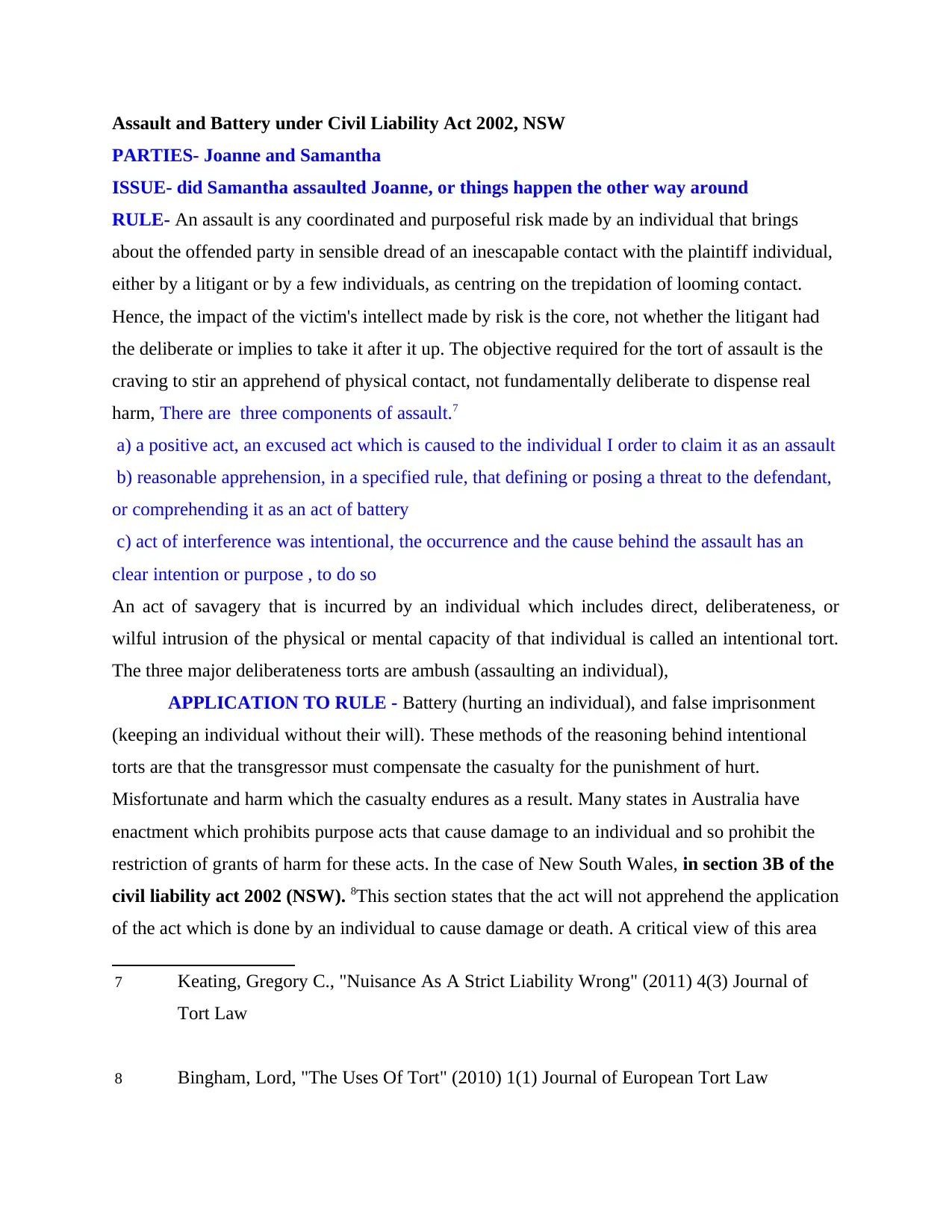
Assault and Battery under Civil Liability Act 2002, NSW
PARTIES- Joanne and Samantha
ISSUE- did Samantha assaulted Joanne, or things happen the other way around
RULE- An assault is any coordinated and purposeful risk made by an individual that brings
about the offended party in sensible dread of an inescapable contact with the plaintiff individual,
either by a litigant or by a few individuals, as centring on the trepidation of looming contact.
Hence, the impact of the victim's intellect made by risk is the core, not whether the litigant had
the deliberate or implies to take it after it up. The objective required for the tort of assault is the
craving to stir an apprehend of physical contact, not fundamentally deliberate to dispense real
harm, There are three components of assault.7
a) a positive act, an excused act which is caused to the individual I order to claim it as an assault
b) reasonable apprehension, in a specified rule, that defining or posing a threat to the defendant,
or comprehending it as an act of battery
c) act of interference was intentional, the occurrence and the cause behind the assault has an
clear intention or purpose , to do so
An act of savagery that is incurred by an individual which includes direct, deliberateness, or
wilful intrusion of the physical or mental capacity of that individual is called an intentional tort.
The three major deliberateness torts are ambush (assaulting an individual),
APPLICATION TO RULE - Battery (hurting an individual), and false imprisonment
(keeping an individual without their will). These methods of the reasoning behind intentional
torts are that the transgressor must compensate the casualty for the punishment of hurt.
Misfortunate and harm which the casualty endures as a result. Many states in Australia have
enactment which prohibits purpose acts that cause damage to an individual and so prohibit the
restriction of grants of harm for these acts. In the case of New South Wales, in section 3B of the
civil liability act 2002 (NSW). 8This section states that the act will not apprehend the application
of the act which is done by an individual to cause damage or death. A critical view of this area
7 Keating, Gregory C., "Nuisance As A Strict Liability Wrong" (2011) 4(3) Journal of
Tort Law
8 Bingham, Lord, "The Uses Of Tort" (2010) 1(1) Journal of European Tort Law
PARTIES- Joanne and Samantha
ISSUE- did Samantha assaulted Joanne, or things happen the other way around
RULE- An assault is any coordinated and purposeful risk made by an individual that brings
about the offended party in sensible dread of an inescapable contact with the plaintiff individual,
either by a litigant or by a few individuals, as centring on the trepidation of looming contact.
Hence, the impact of the victim's intellect made by risk is the core, not whether the litigant had
the deliberate or implies to take it after it up. The objective required for the tort of assault is the
craving to stir an apprehend of physical contact, not fundamentally deliberate to dispense real
harm, There are three components of assault.7
a) a positive act, an excused act which is caused to the individual I order to claim it as an assault
b) reasonable apprehension, in a specified rule, that defining or posing a threat to the defendant,
or comprehending it as an act of battery
c) act of interference was intentional, the occurrence and the cause behind the assault has an
clear intention or purpose , to do so
An act of savagery that is incurred by an individual which includes direct, deliberateness, or
wilful intrusion of the physical or mental capacity of that individual is called an intentional tort.
The three major deliberateness torts are ambush (assaulting an individual),
APPLICATION TO RULE - Battery (hurting an individual), and false imprisonment
(keeping an individual without their will). These methods of the reasoning behind intentional
torts are that the transgressor must compensate the casualty for the punishment of hurt.
Misfortunate and harm which the casualty endures as a result. Many states in Australia have
enactment which prohibits purpose acts that cause damage to an individual and so prohibit the
restriction of grants of harm for these acts. In the case of New South Wales, in section 3B of the
civil liability act 2002 (NSW). 8This section states that the act will not apprehend the application
of the act which is done by an individual to cause damage or death. A critical view of this area
7 Keating, Gregory C., "Nuisance As A Strict Liability Wrong" (2011) 4(3) Journal of
Tort Law
8 Bingham, Lord, "The Uses Of Tort" (2010) 1(1) Journal of European Tort Law
Paraphrase This Document
Need a fresh take? Get an instant paraphrase of this document with our AI Paraphraser
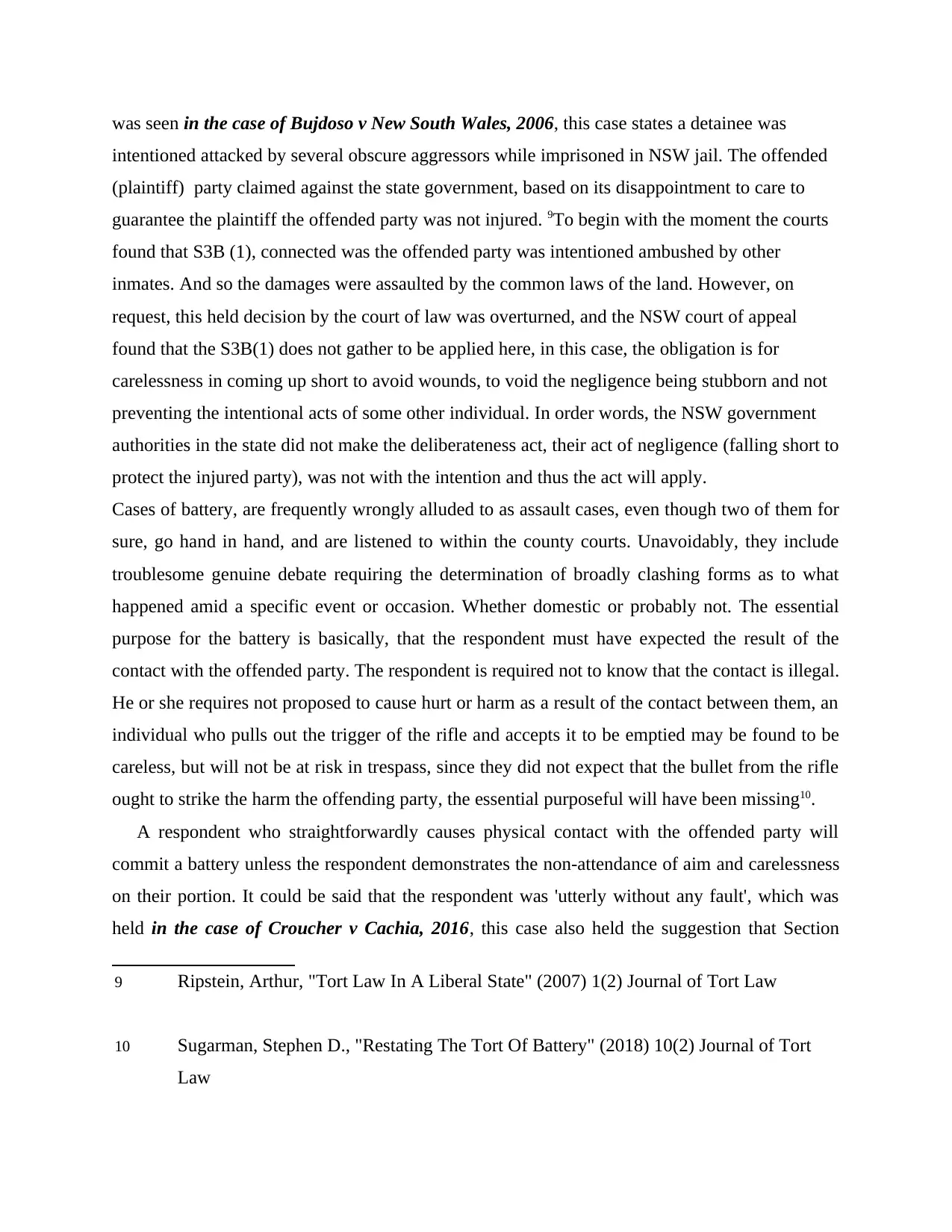
was seen in the case of Bujdoso v New South Wales, 2006, this case states a detainee was
intentioned attacked by several obscure aggressors while imprisoned in NSW jail. The offended
(plaintiff) party claimed against the state government, based on its disappointment to care to
guarantee the plaintiff the offended party was not injured. 9To begin with the moment the courts
found that S3B (1), connected was the offended party was intentioned ambushed by other
inmates. And so the damages were assaulted by the common laws of the land. However, on
request, this held decision by the court of law was overturned, and the NSW court of appeal
found that the S3B(1) does not gather to be applied here, in this case, the obligation is for
carelessness in coming up short to avoid wounds, to void the negligence being stubborn and not
preventing the intentional acts of some other individual. In order words, the NSW government
authorities in the state did not make the deliberateness act, their act of negligence (falling short to
protect the injured party), was not with the intention and thus the act will apply.
Cases of battery, are frequently wrongly alluded to as assault cases, even though two of them for
sure, go hand in hand, and are listened to within the county courts. Unavoidably, they include
troublesome genuine debate requiring the determination of broadly clashing forms as to what
happened amid a specific event or occasion. Whether domestic or probably not. The essential
purpose for the battery is basically, that the respondent must have expected the result of the
contact with the offended party. The respondent is required not to know that the contact is illegal.
He or she requires not proposed to cause hurt or harm as a result of the contact between them, an
individual who pulls out the trigger of the rifle and accepts it to be emptied may be found to be
careless, but will not be at risk in trespass, since they did not expect that the bullet from the rifle
ought to strike the harm the offending party, the essential purposeful will have been missing10.
A respondent who straightforwardly causes physical contact with the offended party will
commit a battery unless the respondent demonstrates the non-attendance of aim and carelessness
on their portion. It could be said that the respondent was 'utterly without any fault', which was
held in the case of Croucher v Cachia, 2016, this case also held the suggestion that Section
9 Ripstein, Arthur, "Tort Law In A Liberal State" (2007) 1(2) Journal of Tort Law
10 Sugarman, Stephen D., "Restating The Tort Of Battery" (2018) 10(2) Journal of Tort
Law
intentioned attacked by several obscure aggressors while imprisoned in NSW jail. The offended
(plaintiff) party claimed against the state government, based on its disappointment to care to
guarantee the plaintiff the offended party was not injured. 9To begin with the moment the courts
found that S3B (1), connected was the offended party was intentioned ambushed by other
inmates. And so the damages were assaulted by the common laws of the land. However, on
request, this held decision by the court of law was overturned, and the NSW court of appeal
found that the S3B(1) does not gather to be applied here, in this case, the obligation is for
carelessness in coming up short to avoid wounds, to void the negligence being stubborn and not
preventing the intentional acts of some other individual. In order words, the NSW government
authorities in the state did not make the deliberateness act, their act of negligence (falling short to
protect the injured party), was not with the intention and thus the act will apply.
Cases of battery, are frequently wrongly alluded to as assault cases, even though two of them for
sure, go hand in hand, and are listened to within the county courts. Unavoidably, they include
troublesome genuine debate requiring the determination of broadly clashing forms as to what
happened amid a specific event or occasion. Whether domestic or probably not. The essential
purpose for the battery is basically, that the respondent must have expected the result of the
contact with the offended party. The respondent is required not to know that the contact is illegal.
He or she requires not proposed to cause hurt or harm as a result of the contact between them, an
individual who pulls out the trigger of the rifle and accepts it to be emptied may be found to be
careless, but will not be at risk in trespass, since they did not expect that the bullet from the rifle
ought to strike the harm the offending party, the essential purposeful will have been missing10.
A respondent who straightforwardly causes physical contact with the offended party will
commit a battery unless the respondent demonstrates the non-attendance of aim and carelessness
on their portion. It could be said that the respondent was 'utterly without any fault', which was
held in the case of Croucher v Cachia, 2016, this case also held the suggestion that Section
9 Ripstein, Arthur, "Tort Law In A Liberal State" (2007) 1(2) Journal of Tort Law
10 Sugarman, Stephen D., "Restating The Tort Of Battery" (2018) 10(2) Journal of Tort
Law
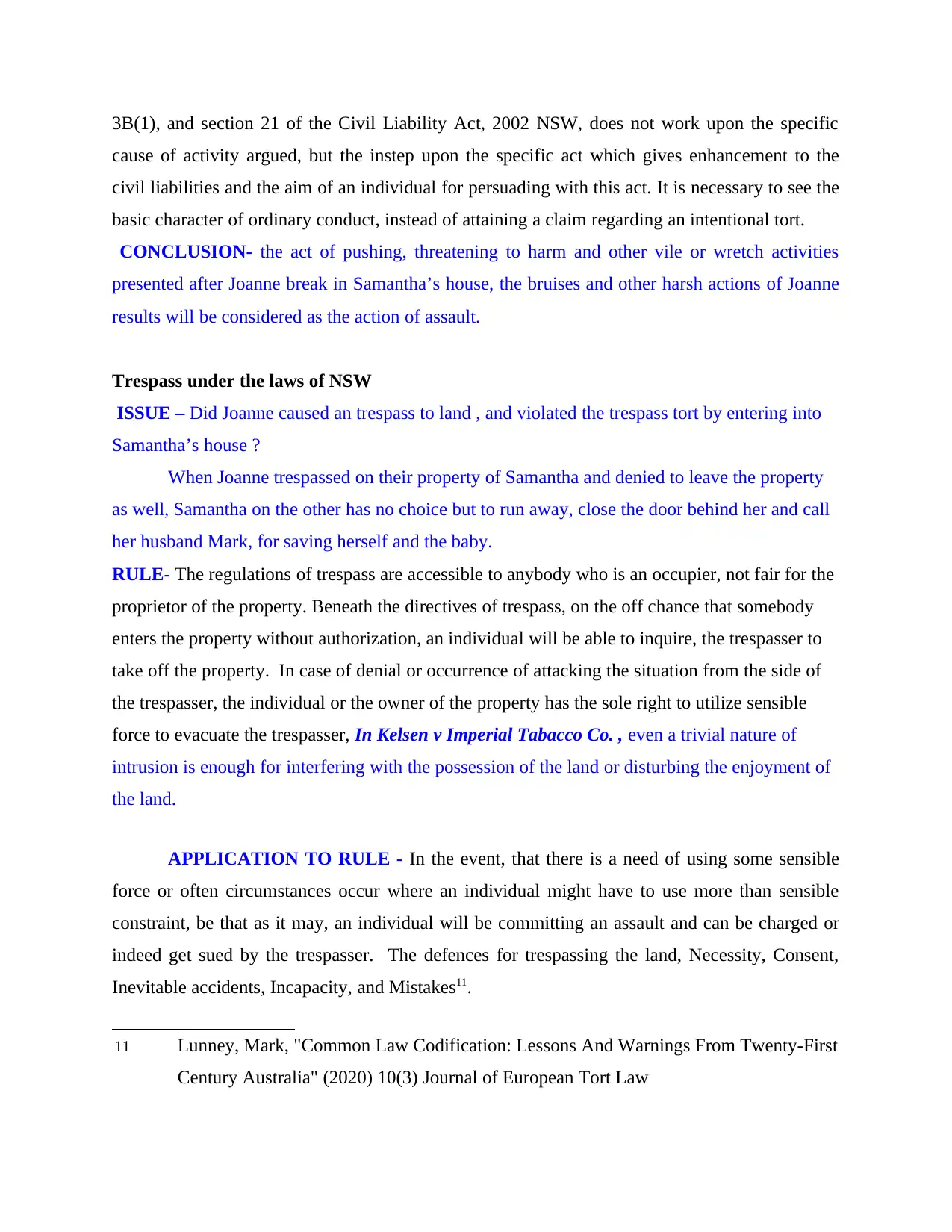
3B(1), and section 21 of the Civil Liability Act, 2002 NSW, does not work upon the specific
cause of activity argued, but the instep upon the specific act which gives enhancement to the
civil liabilities and the aim of an individual for persuading with this act. It is necessary to see the
basic character of ordinary conduct, instead of attaining a claim regarding an intentional tort.
CONCLUSION- the act of pushing, threatening to harm and other vile or wretch activities
presented after Joanne break in Samantha’s house, the bruises and other harsh actions of Joanne
results will be considered as the action of assault.
Trespass under the laws of NSW
ISSUE – Did Joanne caused an trespass to land , and violated the trespass tort by entering into
Samantha’s house ?
When Joanne trespassed on their property of Samantha and denied to leave the property
as well, Samantha on the other has no choice but to run away, close the door behind her and call
her husband Mark, for saving herself and the baby.
RULE- The regulations of trespass are accessible to anybody who is an occupier, not fair for the
proprietor of the property. Beneath the directives of trespass, on the off chance that somebody
enters the property without authorization, an individual will be able to inquire, the trespasser to
take off the property. In case of denial or occurrence of attacking the situation from the side of
the trespasser, the individual or the owner of the property has the sole right to utilize sensible
force to evacuate the trespasser, In Kelsen v Imperial Tabacco Co. , even a trivial nature of
intrusion is enough for interfering with the possession of the land or disturbing the enjoyment of
the land.
APPLICATION TO RULE - In the event, that there is a need of using some sensible
force or often circumstances occur where an individual might have to use more than sensible
constraint, be that as it may, an individual will be committing an assault and can be charged or
indeed get sued by the trespasser. The defences for trespassing the land, Necessity, Consent,
Inevitable accidents, Incapacity, and Mistakes11.
11 Lunney, Mark, "Common Law Codification: Lessons And Warnings From Twenty-First
Century Australia" (2020) 10(3) Journal of European Tort Law
cause of activity argued, but the instep upon the specific act which gives enhancement to the
civil liabilities and the aim of an individual for persuading with this act. It is necessary to see the
basic character of ordinary conduct, instead of attaining a claim regarding an intentional tort.
CONCLUSION- the act of pushing, threatening to harm and other vile or wretch activities
presented after Joanne break in Samantha’s house, the bruises and other harsh actions of Joanne
results will be considered as the action of assault.
Trespass under the laws of NSW
ISSUE – Did Joanne caused an trespass to land , and violated the trespass tort by entering into
Samantha’s house ?
When Joanne trespassed on their property of Samantha and denied to leave the property
as well, Samantha on the other has no choice but to run away, close the door behind her and call
her husband Mark, for saving herself and the baby.
RULE- The regulations of trespass are accessible to anybody who is an occupier, not fair for the
proprietor of the property. Beneath the directives of trespass, on the off chance that somebody
enters the property without authorization, an individual will be able to inquire, the trespasser to
take off the property. In case of denial or occurrence of attacking the situation from the side of
the trespasser, the individual or the owner of the property has the sole right to utilize sensible
force to evacuate the trespasser, In Kelsen v Imperial Tabacco Co. , even a trivial nature of
intrusion is enough for interfering with the possession of the land or disturbing the enjoyment of
the land.
APPLICATION TO RULE - In the event, that there is a need of using some sensible
force or often circumstances occur where an individual might have to use more than sensible
constraint, be that as it may, an individual will be committing an assault and can be charged or
indeed get sued by the trespasser. The defences for trespassing the land, Necessity, Consent,
Inevitable accidents, Incapacity, and Mistakes11.
11 Lunney, Mark, "Common Law Codification: Lessons And Warnings From Twenty-First
Century Australia" (2020) 10(3) Journal of European Tort Law
⊘ This is a preview!⊘
Do you want full access?
Subscribe today to unlock all pages.

Trusted by 1+ million students worldwide
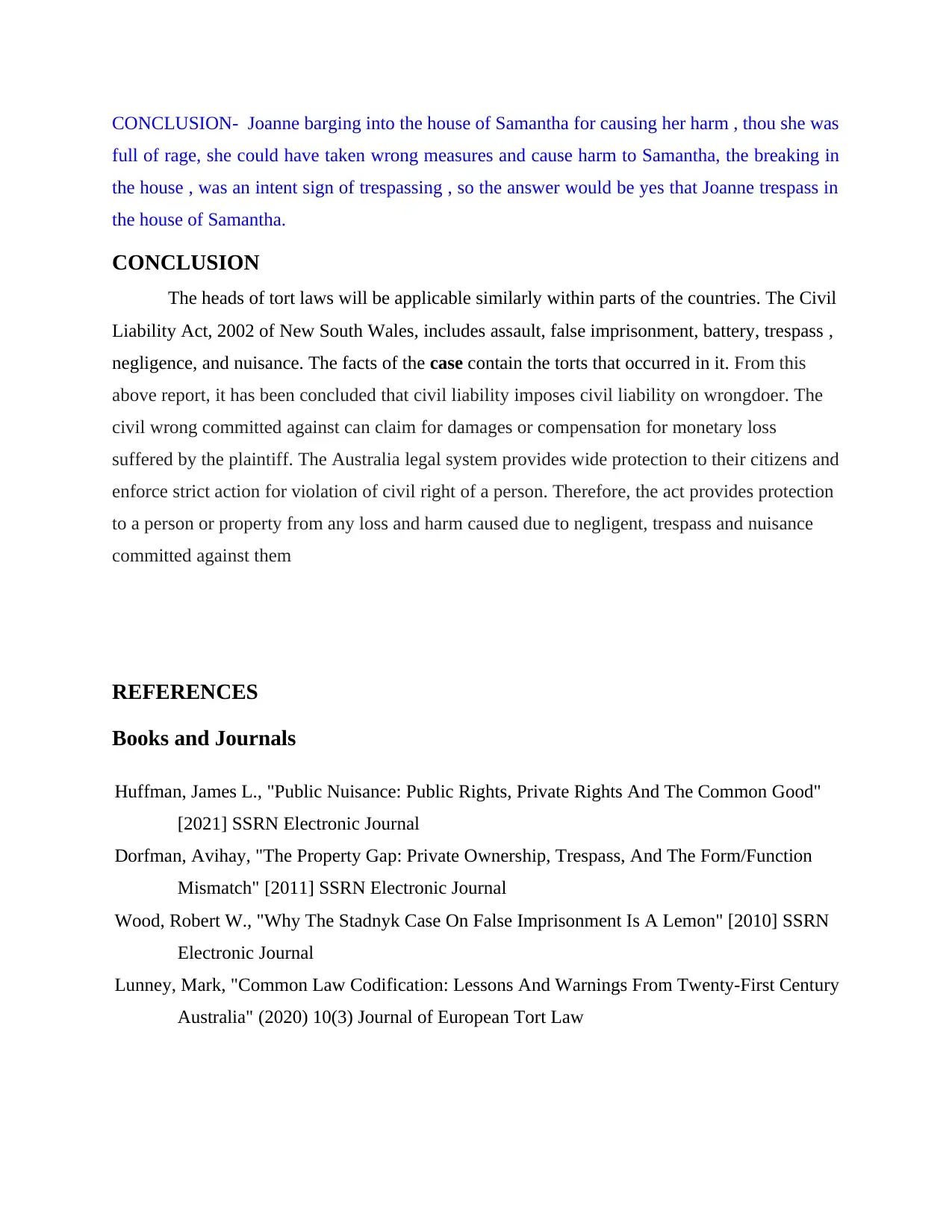
CONCLUSION- Joanne barging into the house of Samantha for causing her harm , thou she was
full of rage, she could have taken wrong measures and cause harm to Samantha, the breaking in
the house , was an intent sign of trespassing , so the answer would be yes that Joanne trespass in
the house of Samantha.
CONCLUSION
The heads of tort laws will be applicable similarly within parts of the countries. The Civil
Liability Act, 2002 of New South Wales, includes assault, false imprisonment, battery, trespass ,
negligence, and nuisance. The facts of the case contain the torts that occurred in it. From this
above report, it has been concluded that civil liability imposes civil liability on wrongdoer. The
civil wrong committed against can claim for damages or compensation for monetary loss
suffered by the plaintiff. The Australia legal system provides wide protection to their citizens and
enforce strict action for violation of civil right of a person. Therefore, the act provides protection
to a person or property from any loss and harm caused due to negligent, trespass and nuisance
committed against them
REFERENCES
Books and Journals
Huffman, James L., "Public Nuisance: Public Rights, Private Rights And The Common Good"
[2021] SSRN Electronic Journal
Dorfman, Avihay, "The Property Gap: Private Ownership, Trespass, And The Form/Function
Mismatch" [2011] SSRN Electronic Journal
Wood, Robert W., "Why The Stadnyk Case On False Imprisonment Is A Lemon" [2010] SSRN
Electronic Journal
Lunney, Mark, "Common Law Codification: Lessons And Warnings From Twenty-First Century
Australia" (2020) 10(3) Journal of European Tort Law
full of rage, she could have taken wrong measures and cause harm to Samantha, the breaking in
the house , was an intent sign of trespassing , so the answer would be yes that Joanne trespass in
the house of Samantha.
CONCLUSION
The heads of tort laws will be applicable similarly within parts of the countries. The Civil
Liability Act, 2002 of New South Wales, includes assault, false imprisonment, battery, trespass ,
negligence, and nuisance. The facts of the case contain the torts that occurred in it. From this
above report, it has been concluded that civil liability imposes civil liability on wrongdoer. The
civil wrong committed against can claim for damages or compensation for monetary loss
suffered by the plaintiff. The Australia legal system provides wide protection to their citizens and
enforce strict action for violation of civil right of a person. Therefore, the act provides protection
to a person or property from any loss and harm caused due to negligent, trespass and nuisance
committed against them
REFERENCES
Books and Journals
Huffman, James L., "Public Nuisance: Public Rights, Private Rights And The Common Good"
[2021] SSRN Electronic Journal
Dorfman, Avihay, "The Property Gap: Private Ownership, Trespass, And The Form/Function
Mismatch" [2011] SSRN Electronic Journal
Wood, Robert W., "Why The Stadnyk Case On False Imprisonment Is A Lemon" [2010] SSRN
Electronic Journal
Lunney, Mark, "Common Law Codification: Lessons And Warnings From Twenty-First Century
Australia" (2020) 10(3) Journal of European Tort Law
Paraphrase This Document
Need a fresh take? Get an instant paraphrase of this document with our AI Paraphraser
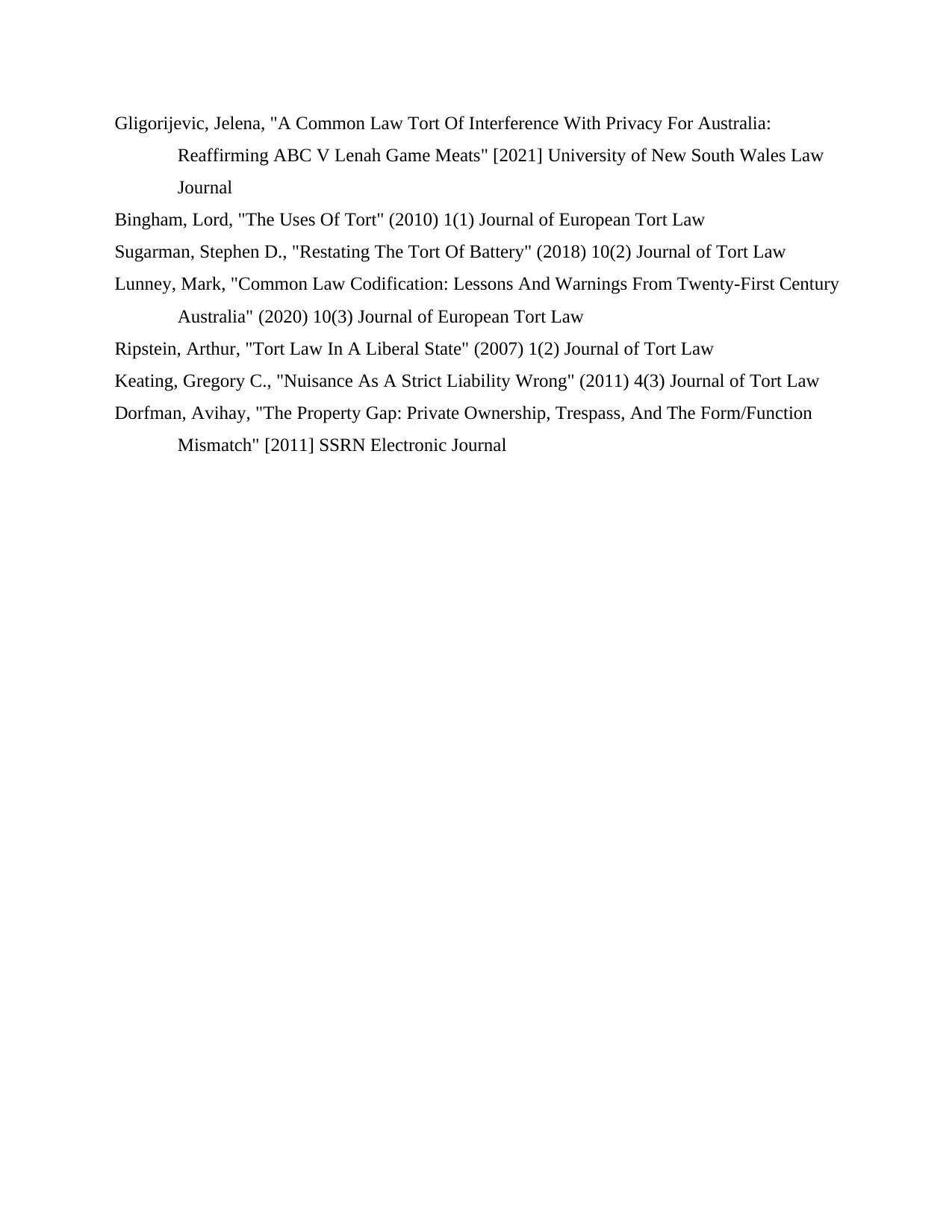
Gligorijevic, Jelena, "A Common Law Tort Of Interference With Privacy For Australia:
Reaffirming ABC V Lenah Game Meats" [2021] University of New South Wales Law
Journal
Bingham, Lord, "The Uses Of Tort" (2010) 1(1) Journal of European Tort Law
Sugarman, Stephen D., "Restating The Tort Of Battery" (2018) 10(2) Journal of Tort Law
Lunney, Mark, "Common Law Codification: Lessons And Warnings From Twenty-First Century
Australia" (2020) 10(3) Journal of European Tort Law
Ripstein, Arthur, "Tort Law In A Liberal State" (2007) 1(2) Journal of Tort Law
Keating, Gregory C., "Nuisance As A Strict Liability Wrong" (2011) 4(3) Journal of Tort Law
Dorfman, Avihay, "The Property Gap: Private Ownership, Trespass, And The Form/Function
Mismatch" [2011] SSRN Electronic Journal
Reaffirming ABC V Lenah Game Meats" [2021] University of New South Wales Law
Journal
Bingham, Lord, "The Uses Of Tort" (2010) 1(1) Journal of European Tort Law
Sugarman, Stephen D., "Restating The Tort Of Battery" (2018) 10(2) Journal of Tort Law
Lunney, Mark, "Common Law Codification: Lessons And Warnings From Twenty-First Century
Australia" (2020) 10(3) Journal of European Tort Law
Ripstein, Arthur, "Tort Law In A Liberal State" (2007) 1(2) Journal of Tort Law
Keating, Gregory C., "Nuisance As A Strict Liability Wrong" (2011) 4(3) Journal of Tort Law
Dorfman, Avihay, "The Property Gap: Private Ownership, Trespass, And The Form/Function
Mismatch" [2011] SSRN Electronic Journal
1 out of 11
Related Documents
Your All-in-One AI-Powered Toolkit for Academic Success.
+13062052269
info@desklib.com
Available 24*7 on WhatsApp / Email
![[object Object]](/_next/static/media/star-bottom.7253800d.svg)
Unlock your academic potential
Copyright © 2020–2025 A2Z Services. All Rights Reserved. Developed and managed by ZUCOL.



